Mani Rimdu is a religious festival dedicated to Chyenrezig, the deity of dance and compassion, who brings peace and harmony to the world, and who is invoked when the well-known mantra Om Mani Padme Hum is recited (Praise to the Jewel in the Lotus!)
Having left Khumbu so early due to the Covid-19, I missed the last two and most important Sherpa festivals, Thame’s Mani Rimdu and Dumchi, which will be held in several Khumbu villages at first of July. Sherpas celebrate many festivals which, in addition to the religious aspect, are the occasions that families and friends have for fun, social life and relax.
In this post and the next one, with the collaboration of my friend Pasang, I will try to explain the origin and meaning of these two festivals.
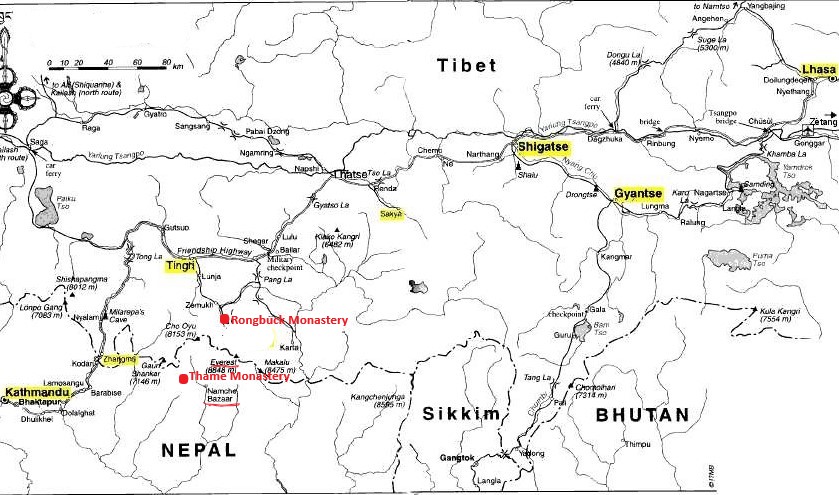
The Mani Rimdu of Thame
From what I am told, this year has been an unusual celebration as, due to the lockdown of the country, only people from the villages around Thame were able to attend. This has made it an “intimate” festival for the Sherpas of that area.
In the Khumbu is celebrated in Tengboche Monastery in November, and in Thame Monastery in late May or early June, as appropriate according to the Tibetan calendar. It lasts two weeks at the end of which there are three days with public attendance, which this year were from June 1 to 3.
The celebration of the Mani Rimdu was introduced to Khumbu just over 90 years ago from the Rongphu monastery in Tibet, where unfortunately this tradition was interrupted in 1959 when this Tibetan monastery, like so many others, was destroyed during the Chinese Cultural Revolution.
In the 1980s the Chinese government authorized the reconstruction of Buddhist monasteries in Tibet. In 2002, after the Rongphu one was rebuilt, the monks wanted to restore the tradition of celebrating the Mani Rimdu but none of them knew how it was done because they had never seen the dances that are the essence of the celebration. With the support of the Mountain Institute of Nepal, the monks of Rongphu went to Thame Monastery to learn the dances and in 2004 they restored the celebration which has been celebrated since then every year. Rongphu can be said that has a “return” celebration.
The preparation of the Mani Rimdu lasts 7 days starting with the ceremony for the protection of the people and the land (this year it was May 25). During the following days monks prepare the tormas, which are figures of various shapes, very worked, made with a dough based on boiled rice, and a mandala made with dyed sand of many colours and which are real watermarks that can only be done with infinite patience like they have.
Monks also prepare and bless the rilbu which are reddish pills, which are attributed long-life properties, and which are distributed to the attendees during the last days of the celebration. They also rehearse the mask dances and performances that will take place in the last three days, already with the public.
On the first day of the public acts the blessing ceremony called Tsewang is held during which the rilbu is distributed among the attendees. On the second day the lamas perform the Chhaam, a spectacular mask dance. The celebration ends on the third day with the zigshag which is an offering ceremony with fire, for the deities.
The next morning the llamas make a final offering to the spirits of the water and throw the sand of the mandalas into the river.
Rilbu, the pills of health and long life
These pills are made with rice flour mixed with various ingredients that include plants and other medicinal substances, powder of 5 precious metals (gold, silver, copper, brass and iron) and various blessed substances. They then put them in bags that the younger monks spin to dry, while walking around the monastery. Once dry, they are painted red with the product obtained from a medicinal substance called tshal. Once the elaboration is finished, they bless them, and they are about to be distributed to the attendees.
The coloured sand mandalas
Mandalas, in the Buddhist tradition, are a representation of the universe or a space bounded by a circle where deities are invited through various rituals or mantras.
Although its form and structure may vary according to the deities it includes, the basic elements are always the same, the palace of the deities, their gates, and the protective circles. The palace, usually a square, is in the centre on a cross of vajras (mystical weapon), which rests on a lotus flower, a symbol of the purity of the universe. The palace usually has four gates adorned with porticos of very elaborate designs, crowned by a Dharmachakra (Wheel of Dharma) and a pair of deer. The square is usually surrounded by two protective circles, one of vajras, symbolizing the indestructible nature of reality, and a circle of fire.
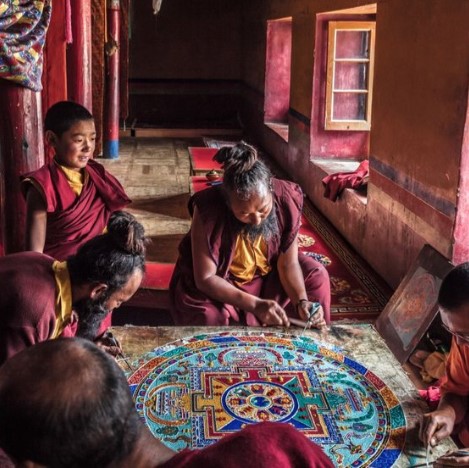
Lamas making a mandala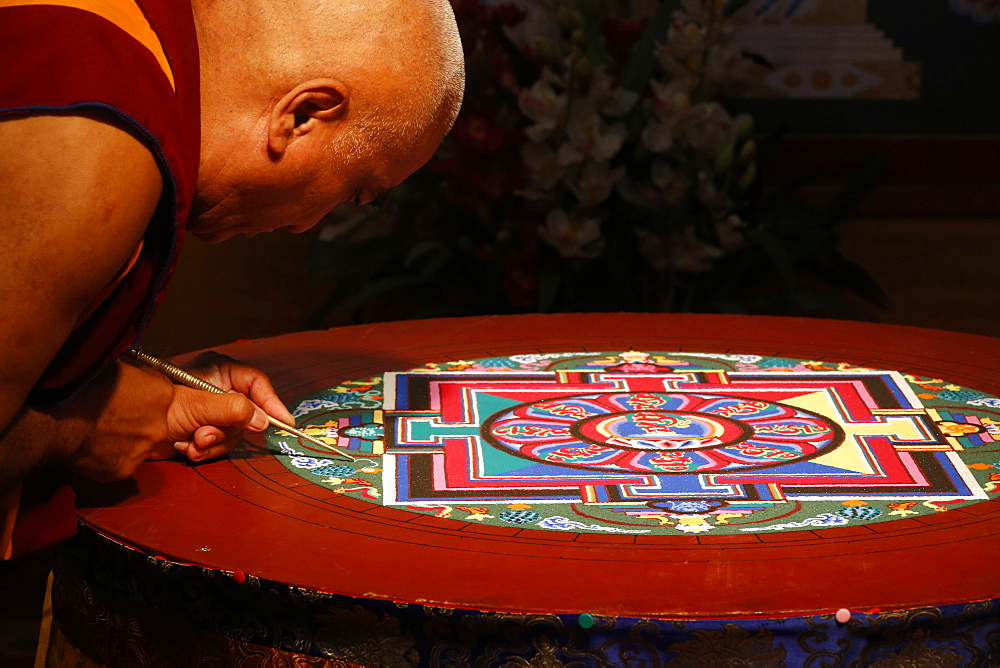
Mandala made with coloured sand
Mandalas for special rituals are made with powder, grains or flowers of different colours. For Thame’s Mani Rimdu the mandala is prepared on a wooden board using very fine sand coloured with vegetable dyes. The drawings are created, from the centre to the edges, depositing small amounts of coloured sand using a chakpu, a very narrow funnel.
Dresses, masks and hats
The dresses, in a wide variety of colours, are very heavy, Chinese-style, and are made of silk fabrics.
Masks are considered sacred objects and when used for a long time are believed to be endowed with the power of the deities they represent and have a life of their own. They are made with a clay mould, which when dry is covered with layers of glued cloth. Then they break the mould, paint it and decorate it with hair, ribbons and handkerchiefs. Some are crowned with a diadem with several skulls. To simulate hair, they use yak tail hair.
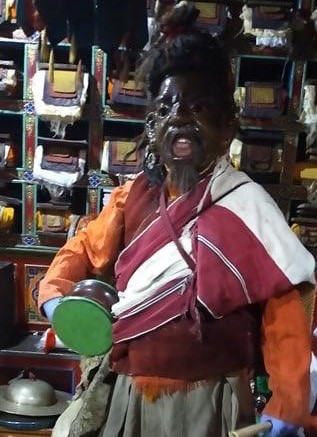
The Thogden caracter mask 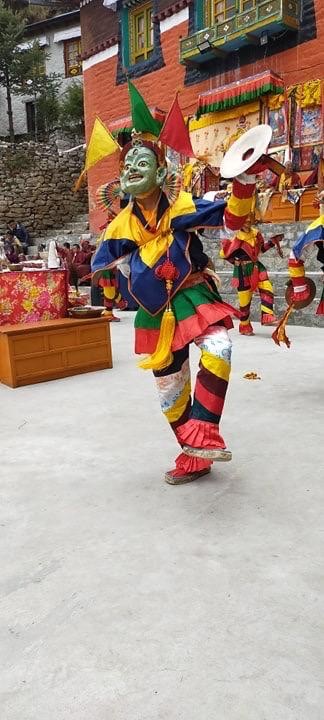
Dancer wearing a colourful dress
They have a great diversity of hats. During the ceremonies, the lamas wear the tsezha, a yellow felt hat in the shape of a cook’s comb. The abbot of the monastery uses the so-called pering, made of red felt and with a peculiar shape with a pointed end. In the picture of the presidency of this year’s dance ceremony at Thame Monastery, you can see four lamas wearing the tsezha and on the left the reincarnated lama (who is a 10-year-old boy) wearing the pering.
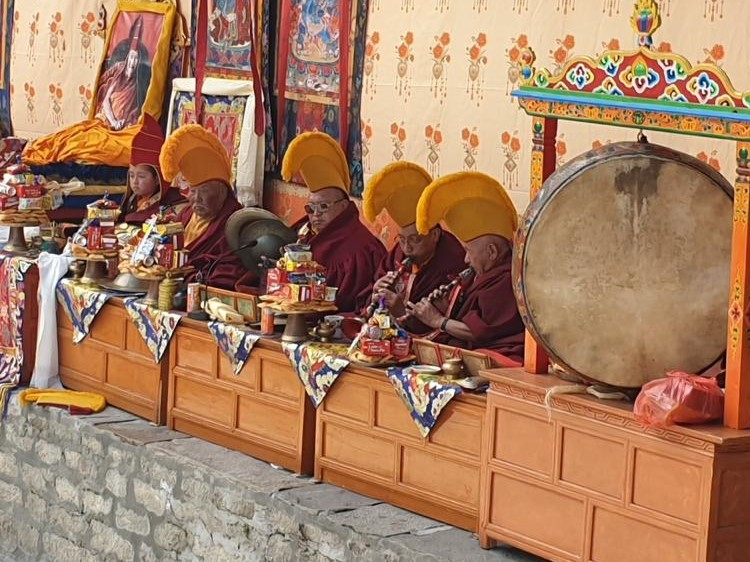
For some of the dances, the monks wear hats called shanags, also known as black hats, which symbolize the existence of the world.
As you can see in the pictures, the costumes, masks and hats are real craft works.
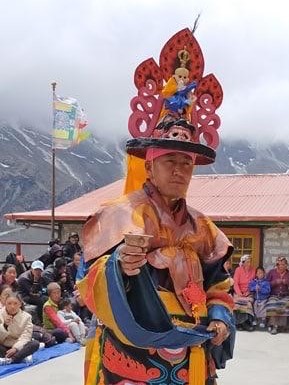
Lama with a shanag (black hat) 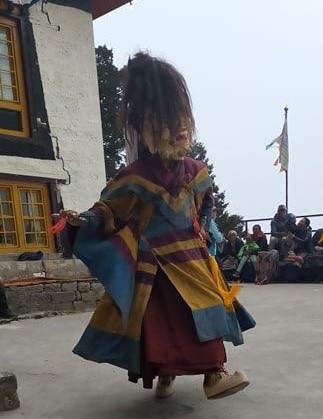
Dancer with a mask topped with yak hair
Chhaams, the sacred dances
The second day of the public part is the day most awaited by the inhabitants of the area. It is the day when the lamas dance the Chhaams and to do so they transform using the spectacular dresses, masks and hats, special for the occasion.
The dances take place in the courtyard of the monastery where they place a very elaborate altar and the mandala that they have prepared in the early days.
The program lasts all day and consists of 15 performances among dances and acts, where dances are mixed accompanied by simple instruments (cymbals or drums) played by the dancers themselves, with other dances where the characters evolve to the music of long horns and cymbals. There are two comic interludes, Mi Tsering (The Old Man) and Thogden. The latter performance can last up to 1 hour and is the most awaited by people. During the performance, in between jokes, he takes the opportunity to pass religious messages.
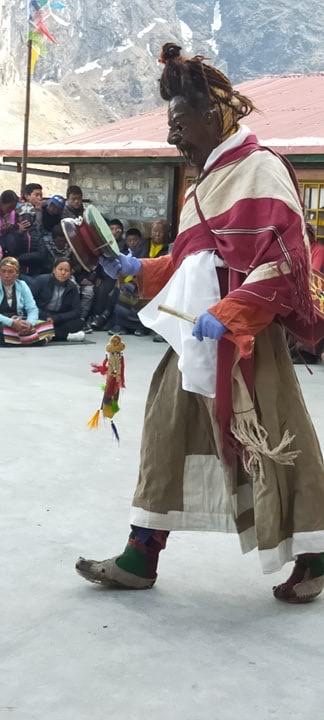
The program ends at the evening with the Ensemble dance in which all the dancers who have performed during the day take part and at the end they return in procession to the interior of the monastery.
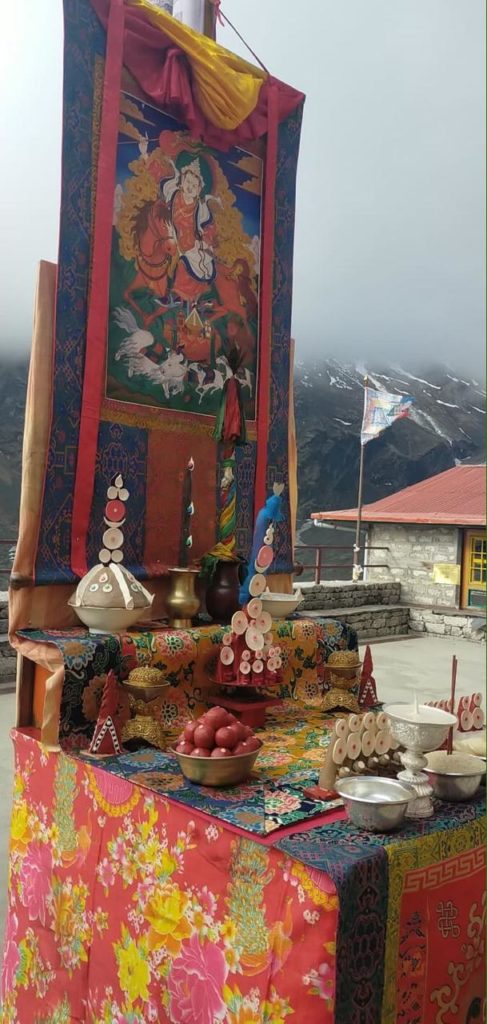
Thame’s Mani Rimdu 2020 altar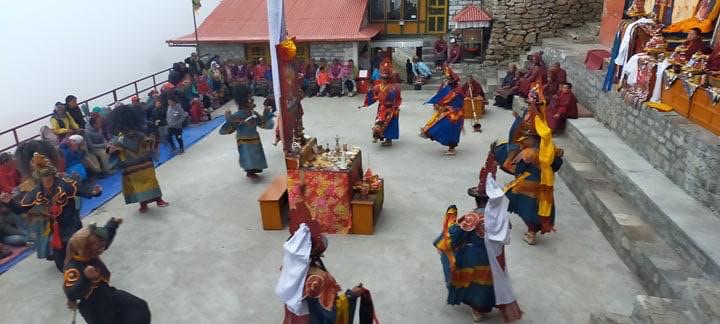
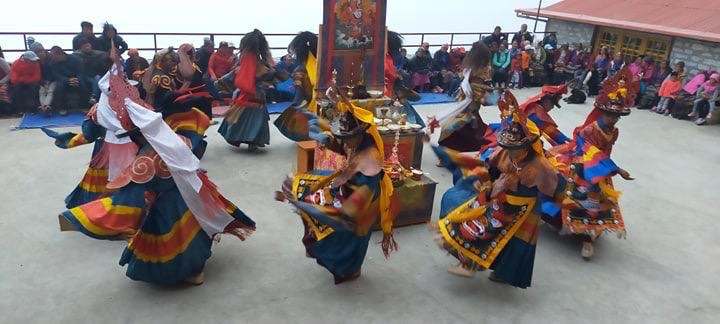
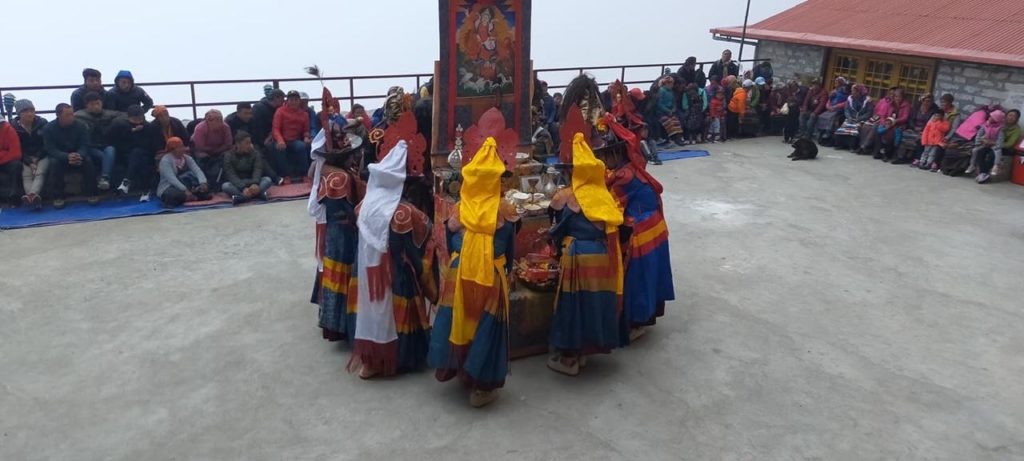
The Ensemble Dance, the last performance
At the end, the attendees go home for dinner and later return to sing and dance Sherpa folk dances while drinking chhang until well into the night. A secular end for the most important religious festival in Khumbu.
I had already seen Mani Rimdu on other occasions but then I knew neither the Sherpa culture nor the meaning of the dances and rituals of this festival as I know it now. That is why I am convinced that the day I can return to Khumbu and attend this festival, I will no longer see it only as a spectacle, which it is, but that my western eyes will have a filter that will allow me to see beyond it, and better understand its meaning. Knowing the simple way of life of the Sherpas and how they keep their culture, a saying comes to my mind: savour every moment and you will savour the life. And that’s what they do!
The Mani Rimdu of Thame 2020 pictures were provided to by Pasang Gelje Sherpa, from Namche